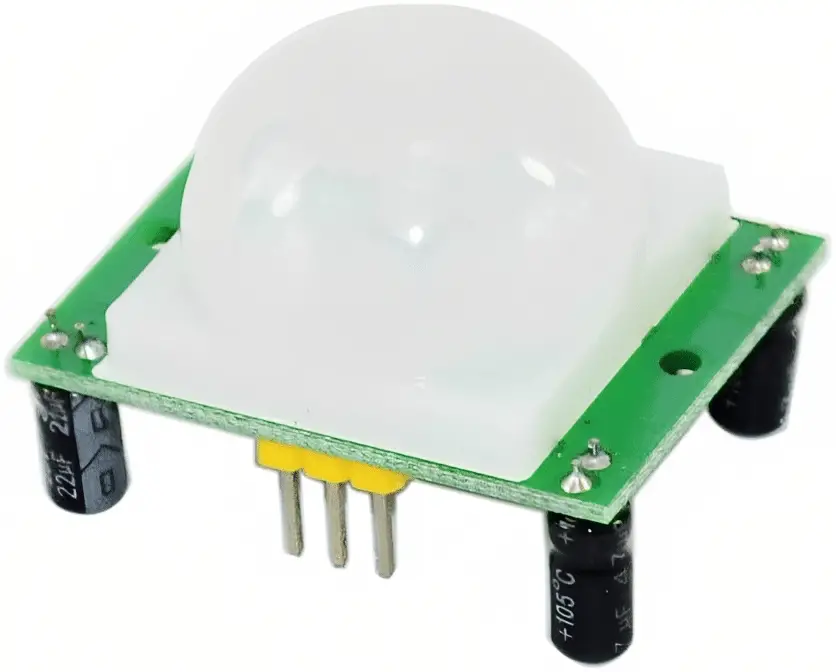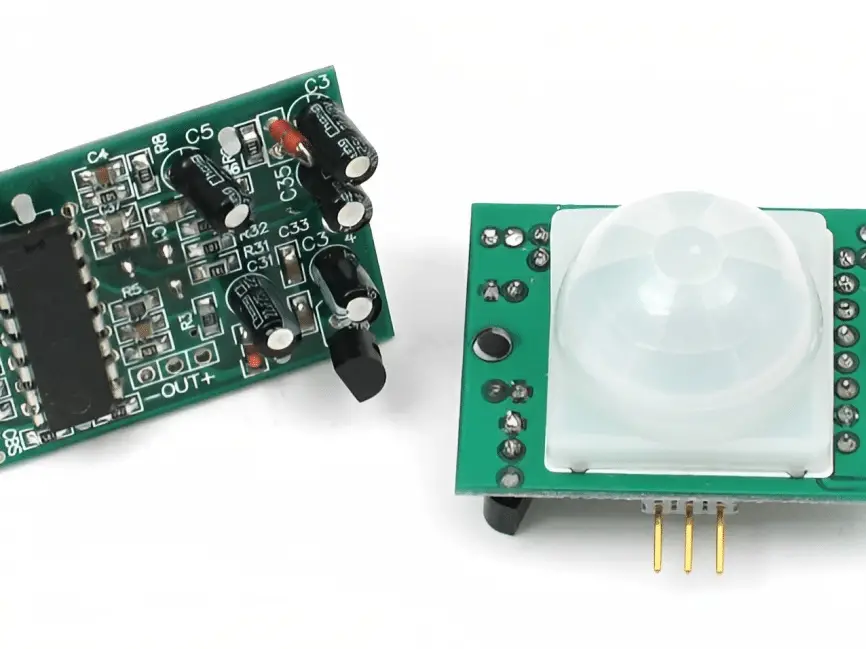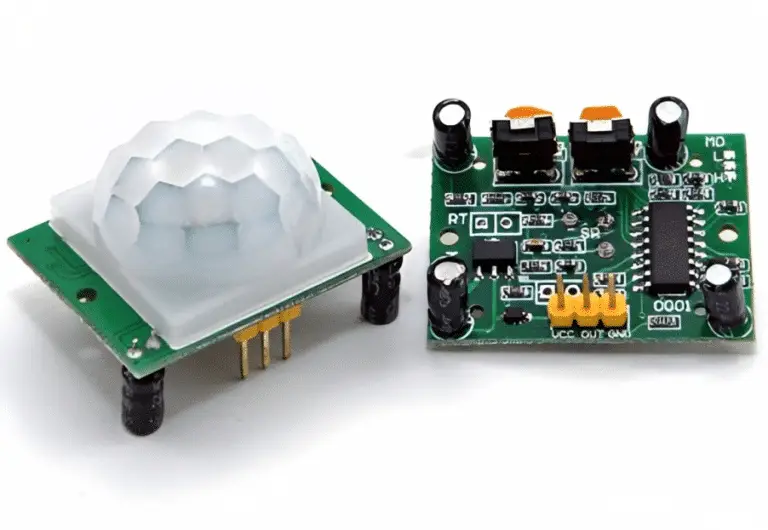Introduction
A Passive Infrared (PIR) motion sensor is a common type of electronic device that detects motion based on changes in infrared radiation within its range. Security, automatic lighting, and energy management systems use PIR sensors. By detecting the heat emitted by living beings and other objects, PIR motion sensors provide a reliable and cost-effective solution for monitoring and triggering actions in response to movement.
At the core of a PIR motion sensor is a pyroelectric sensor, which consists of a thin film made of pyroelectric materials. These materials have the unique property of generating an electric charge when exposed to rapid changes in temperature. The sensor has numerous zones with Fresnel lenses to focus infrared radiation on the pyroelectric substance. When a person or object moves within the sensor’s detection range, the sensor detects the change in the infrared energy pattern, resulting in a voltage spike that triggers a response.
One of the significant advantages of PIR motion sensors is their ability to operate without the need for direct contact or physical interaction. Unlike other motion detection technologies that rely on ultrasonic waves or microwave signals, PIR sensors work by detecting the natural heat signatures emitted by living beings and objects. This non-invasive detection method makes PIR sensors ideal for use in security systems, where they can detect human presence and trigger alarms or activate surveillance cameras.

How does a PIR motion sensor work?
PIR or passive infrared sensors detect infrared from all heat-emitting items. This emission is invisible to the human eye, but infrared sensors can detect it.
Security, automatic lighting, and home automation use PIR motion sensors. The premise behind PIR motion sensors is simple but effective.
Multiple sensor elements in the PIR sensor generate an electric charge when exposed to infrared radiation from objects or living things. These elements frequently react to infrared energy changes in their area of view.
The sensor elements detect this shift in infrared radiation when an object or person enters its detecting range due to the temperature contrast. The sensor elements’ electrical signal is amplified by the PIR sensor circuit.
What is the difference between PIR sensor and motion sensor?
PIR Sensors: – It is a type of sensor that detects motion. Motion sensors come in various types and PIR is one of them. All the motion sensors are not PIR sensors and all the PIR sensors are also not motion sensors. It works on the principle of Infrared rays and that’s why it is called PIR sensors.
The difference between a PIR (Passive Infrared) sensor and a motion sensor lies in their underlying technology and the way they detect movement.
PIR Sensor
PIR motion sensors detect variations in object-emitted infrared radiation. Two pyroelectric sensors generate an electric charge when exposed to infrared radiation. The sensor detects motion when an object moves within its detecting range by changing the infrared emission pattern. Security systems, automatic lighting, and energy-saving applications use PIR sensors to detect human or animal movement based on body heat.
Motion Sensor
The term “motion sensor” is a broader category that includes various technologies for detecting movement. Besides PIR sensors, other types of motion sensors include ultrasonic sensors, microwave sensors, and even cameras with computer vision capabilities. Each technology has its strengths and weaknesses. For instance, microwave sensors are more sensitive to motion but might be less accurate in identifying the exact nature of the moving object. Ultrasonic sensors, on the other hand, use sound waves to detect motion and are ideal for certain applications.
Why do we use PIR motion sensor?
PIR Sensor Functions
Since humans can’t see IR, we’ve developed electronic detection equipment. Thermal sensing applications like security and motion detection use PIR sensors. Security, motion detection, and automatic lighting employ them.
Due to their effectiveness and versatility, PIR motion sensors are used in many applications. These sensors detect changes in infrared light from objects in their range of vision, making them helpful for motion detection. PIR motion sensors are used for these main reasons:
Energy Efficiency
PIR sensors are passive devices, meaning they don’t emit any energy themselves; they only detect the infrared energy emitted by objects. They are useful for power-saving applications because to their energy efficiency.
Motion Detection
PIR sensors are great for tracking animals and people. They can detect temperature changes caused by moving objects and turn on lights, security alarms, or automated systems.
Cost-Effectiveness
Compared to other motion detection technologies like ultrasonic or microwave sensors, PIR sensors are relatively inexpensive, making them a cost-effective choice for many applications.
Reliable in Specific Areas
PIR sensors work effectively in corridors, parking lots, and indoor locations to detect motion. They operate reliably regardless of wind, rain, or ambient light.
Security
PIR motion sensors play a crucial role in security systems, alerting homeowners or authorities to potential intruders or suspicious activity, enhancing safety and deterring theft or vandalism.

What is the type of PIR motion sensor?
Active and passive infrared sensors exist. As said, passive IR sensors detect infrared radiation and detect motion in security applications. Active infrared sensors are trickier.
PIR motion sensor is passive infrared. Motion-detecting electronics are commonly employed. A PIR motion sensor detects infrared radiation from living things and other objects above absolute zero.
A PIR motion sensor uses a pyroelectric sensor to detect infrared radiation patterns in its area of view. The sensor detects modified infrared radiation when a person or item moves in this field. The sensor’s electronics process the electrical signal to turn on lights, activate an alarm, or unlock a door.
Energy-saving devices, security systems, and automatic lighting use PIR motion sensors. Efficiency, low cost, and reliability make them popular. They can be employed indoors or outdoors as standalone, integrated, or complex systems.
What is PIR sensor range?
What is the Range of PIR Sensor? Indoor passive infrared: Detection distances range from 25 cm to 20 m. Indoor curtain type: The detection distance ranges from 25 cm to 20 m. Outdoor passive infrared: The detection distance ranges from 10 meters to 150 meters.
A Passive Infrared (PIR) sensor’s range refers to the distance at which it can detect movement or changes in infrared radiation emitted by living beings and objects. PIR sensors are commonly used in various applications, such as security systems, automatic lighting, and occupancy detection.
The typical range of a PIR sensor depends on its design and sensitivity settings. In general, most commercial PIR sensors have a range between 5 to 15 meters (approximately 16 to 49 feet). However, some advanced models might have a longer range, reaching up to 30 meters (around 98 feet).
PIR sensors’ effective range is affected by environmental conditions. Extreme temperatures, obstacles, and shiny surfaces can restrict detection distance. PIR sensors have viewing angles of 90 to 180 degrees, which might affect range.
When deploying PIR sensors, it’s crucial to consider these factors to ensure accurate and reliable motion detection within the desired range for the intended application. Regular maintenance and testing can also help to keep the sensors functioning optimally over time.
Do PIR sensors use electricity?
PIR-sensor-based lighting devices utilize 1-3 W when off but start when motion is detected.
PIR sensors require electricity. Electronic PIR sensors detect infrared radiation variations in their field of vision. Security systems, lighting control, and other applications use them to detect motion.
Pyroelectric sensors, lenses, and electronics make up PIR sensors. Detecting infrared radiation from living things and objects above absolute zero requires the pyroelectric sensor. When a warm object passes over the sensor’s field of vision, the pyroelectric material detects the change in infrared radiation.
To function properly, PIR sensors require a power source to operate the internal electronics and the pyroelectric sensor. Usually, they operate on low voltage and consume minimal power, making them energy-efficient devices.
PIR sensors use what material?
A ferroelectric LiTaO3 single lead-free crystal is used as the pyroelectric element for Panasonic PIR Motion sensors. Conventional PIR Motion sensors normally use a ceramic base material (e.g. PZT)for the pyroelectric element, which contains lead in many cases.
PIR (Passive Infrared) sensors detect changes in infrared radiation from nearby objects. These sensors are utilized in security systems, motion-activated lighting, and automatic doors. The main substance in PIR sensors is pyroelectric.
Pyroelectric materials possess a unique property that allows them to generate an electric charge when exposed to a change in temperature. This property is the key to the functioning of PIR sensors. When an object, including humans or animals, moves in front of the sensor, it emits infrared radiation, and the temperature in the sensor’s field of view changes. The pyroelectric material reacts to this temperature fluctuation by generating an electric charge.
The sensor usually uses two pyroelectric materials in sequence and opposing orientations. As the object moves within the sensor’s detection range, the temperature differential between the two materials generates a voltage signal, which the sensor’s circuitry amplifies and processes to turn on a light or alert.
Pyroelectric PIR sensors are great for motion detection due to their sensitivity, dependability, and inexpensive cost.
What is the speed of PIR motion sensor?
0.3s – 25s
If the PIR sensor detects infrared energy, its SIG pin outputs HIGH, activating the motion detector. Two potentiometers on its circuit board change the detecting range and response speed from 0.3s to 25s and up to 6 meters.
The speed of a PIR (Passive Infrared) motion sensor refers to its response time in detecting motion. When an object enters the sensor’s field of view, it emits infrared radiation that the PIR sensor can detect. The sensor then analyzes the changes in the infrared patterns to determine the presence of motion.
The speed or response time of a PIR motion sensor is generally very fast, typically ranging from milliseconds to a few seconds. It is designed to detect and respond to motion quickly and efficiently. The exact speed may vary depending on the specific model and manufacturer, but most PIR sensors have rapid response capabilities.
The high-speed detection of PIR sensors is crucial in various applications, especially in security systems. By quickly sensing motion, they can trigger alarms, activate lights, or initiate other actions to alert homeowners or security personnel of potential intrusions.
The speed of a PIR motion sensor can be altered by temperature, humidity, and obstructions. These factors can influence the sensitivity and response time of the sensor.

Conclusion
PIR motion sensors are useful electronic devices that detect motion by measuring infrared radiation fluctuations. PIR motion sensors use pyroelectric sensors to convert heat from live organisms and objects into electrical charges, responding to movement. It PIR sensors are efficient, dependable, and frequently used due to their non-contact motion sensing technology.
They are ideal for security systems because they can detect human presence without physical contact and activate alarms or cameras to prevent attackers. Automatic lighting systems use PIR sensors to activate lights only when movement is detected, saving energy and convenience. Energy management systems use these sensors to intelligently adjust HVAC systems based on occupancy, improving energy efficiency.
PIR motion sensors are useful in security, lighting, and energy management due to their adaptability and affordability. Their non-invasiveness, reliability, and ability to operate without physical contact make them popular. PIR motion sensors detect and respond to motion efficiently for home security, energy efficiency, and lighting automation. PIR motion sensors may become more important in numerous industries and increase safety, energy efficiency, and convenience as technology advances.

